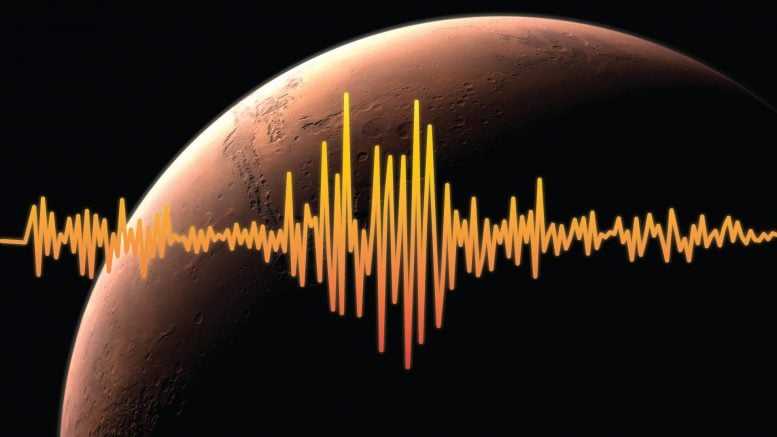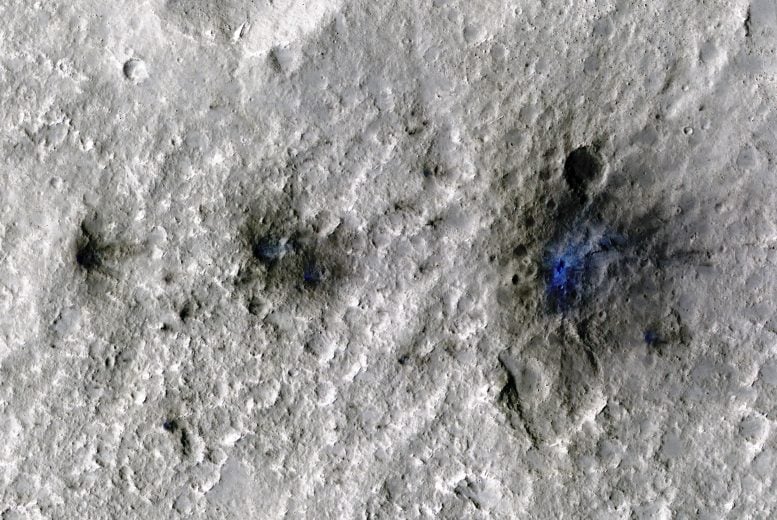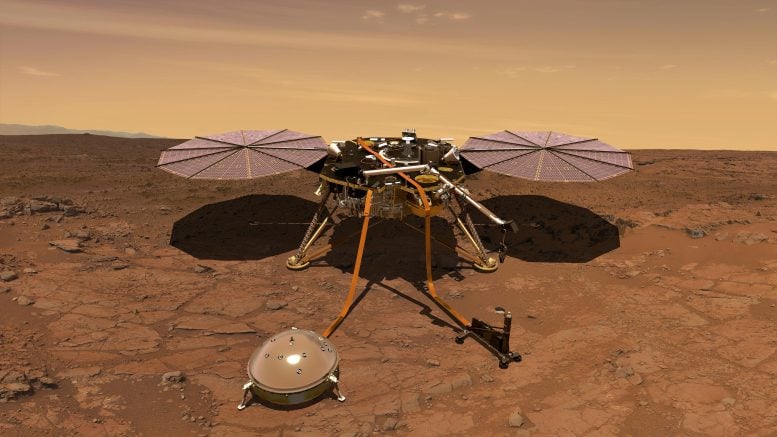
Recent results from the InSight mission reveal that Mars experiences between 280 and 360 large meteorite impacts each year, far exceeding previous estimates based on satellite imagery. This seismic approach offers a new way to date the surfaces of Mars and other planets. Credit: NASA / JPL – Caltech
Seismic signals indicate
” data-gt-translate-attributes=”({“attribute”:”data-cmtooltip”, “format”:”html”})” tabindex=”0″ role=”link”>Mars is hit by about 300 basketball-sized meteorites each year, providing a new tool for dating planetary surfaces.
The scientists involved in
” data-gt-translate-attributes=”({“attribute”:”data-cmtooltip”, “format”:”html”})” tabindex=”0″ role=”link”>NASAThe InSight mission revealed that Mars is subject to far more meteorite impacts than previously thought, with annual rates ranging from 280 to 360 significant impacts. This new understanding stems from seismic data captured by InSight’s seismometer, which suggests a more efficient method for dating planetary surfaces across the solar system.
The new research, conducted by scientists from
” data-gt-translate-attributes=”({“attribute”:”data-cmtooltip”, “format”:”html”})” tabindex=”0″ role=”link”>Imperial College London and ETH Zurich, working as part of NASA’s InSight mission, have shed light on how often “earthquakes” caused by meteorite impacts occur on Mars.
Researchers have found that Mars experiences about 280 to 360 meteorite impacts each year, which produce craters more than eight meters in diameter and shake the surface of the red planet.
The frequency of these earthquakes, detected by InSight’s “seismometer” – an instrument capable of measuring the slightest movements of the ground – exceeds previous estimates based on satellite images of the surface of Mars.

These craters were formed by the impact of a meteorite on Mars on September 5, 2021, the first to be detected by NASA’s InSight. Taken by NASA’s Mars Reconnaissance Orbiter, this color-enhanced image highlights dust and ground disturbed by the impact in blue to make details more visible to the naked eye. Credits: NASA/JPL-Caltech/University of Arizona
Seismic data and planetary dating
Researchers say this seismic data could provide a better, more direct way to measure meteorite impact rates and could help scientists more accurately date planetary surfaces in the solar system.
Natalia Wojcicka, co-first author of the study and a research associate in the Department of Earth Sciences and Engineering at Imperial College London, said: “By using seismic data to better understand how often meteorites strike Mars and how these impacts change its surface, we can begin to piece together a timeline of the Red Planet’s geological history and evolution.
“We could think of it as a kind of cosmic clock to help us date Martian surfaces and perhaps, later, other planets in the solar system.”
The study is published today (June 28) in the journal Natural astronomy.

Collage showing three meteorite impacts that were first detected by NASA’s InSight lander’s seismometer and then captured by the agency’s Mars Reconnaissance Orbiter using its HiRISE camera. Credit: NASA/JPL-Caltech/University of Arizona
Impact craters as cosmic clocks
For years, scientists have used the number of craters on Mars and the surfaces of other planets as “cosmic clocks” to estimate the ages of planets – with older planet surfaces dotted with more craters than older ones. younger.
To calculate planetary ages in this way, scientists have traditionally used models based on the Moon’s craters to predict the impact rate of meteorites of different sizes over time. To apply these models to Mars, they must be adjusted based on how the atmosphere might prevent smaller impactors from hitting the surface as well as the different sizes and positions of Mars in the solar system.
For small craters less than 60 meters wide, Mars scientists have also been able to observe how often new craters form using satellite images – but the number of craters thus discovered is far lower than expected .

Artist’s impression of the InSight lander operating on the surface of Mars. InSight, short for Interior Exploration using Seismic Investigations, Geodesy and Heat Transport, is a lander designed to give Mars its first thorough check since its formation 4.5 billion years ago. Credit: NASA/JPL-Caltech
InSight Seismometer Insights
The new study, part of the InSight mission to understand Mars’ seismic activity and internal structure, has allowed researchers to identify a previously unknown pattern of seismic signals, such as those produced by meteorite impacts. These signals are distinguished by their unusually high proportion of high-frequency waves compared to conventional seismic signals, as well as other characteristics, and are known as “very high-frequency” Marsquakes.
The researchers found that the rate of meteorite impacts was higher than expected by examining freshly formed craters captured by satellite images and consistent with data extrapolated from craters on the Moon’s surface.
This highlighted the limitations of previous models and estimates, as well as the need for better models to understand crater formation and meteorite impacts on Mars.
The Power of Seismic Data in Planetary Science
To solve this problem, the team of scientists used NASA’s InSight lander and its highly sensitive seismometer, SEIS, to record seismic events possibly caused by meteorite impacts.
SEIS detected characteristic seismic signatures of these very high-frequency earthquakes, which researchers found to be indicative of meteoroid impacts and different from other seismic activity.
Using this new method of impact detection, the researchers discovered many more impact events than predicted by satellite imagery, particularly for small impacts that produce craters only a few meters in diameter.
Study co-author Professor Gareth Collins from the Department of Science and Engineering at Imperial College London said: “The SEIS instrument has proven to be incredibly effective in detecting impacts – listening to impacts seems to be more effective than searching for them if we want to understand. how often they occur.
Improving our understanding of the solar system
Researchers believe that deploying smaller, more affordable seismometers on future landers could improve our understanding of impact rates and the internal structure of Mars. These instruments would help researchers detect more seismic signals, providing a more comprehensive data set for understanding meteorite impacts on Mars and other planets, as well as their internal structures.
Dr Wojcicka said: “To understand the internal structure of planets, we use seismology. This is because as seismic waves pass through or reflect off materials in the crust, mantle and core of planets, they change. By studying these changes, seismologists can determine what these layers are made of and how deep they are.
“On Earth, it is easier to understand the internal structure of our planet by observing data from seismometers placed around the globe. However, on Mars, there has only been one: SEIS. To better understand the internal structure of Mars, we need more seismometers spread across the planet. »
As well as new research published in Natural astronomyThe team is also involved in another study published in
Source link